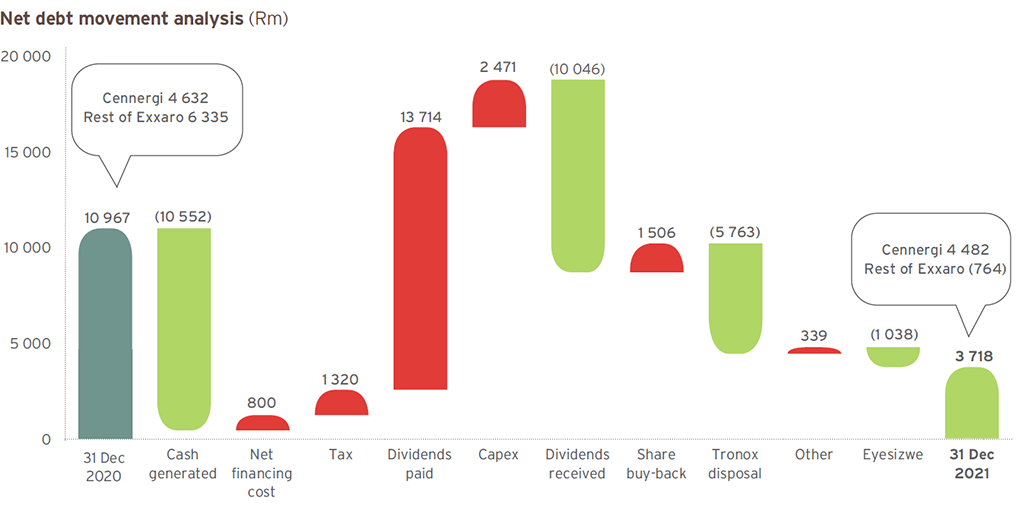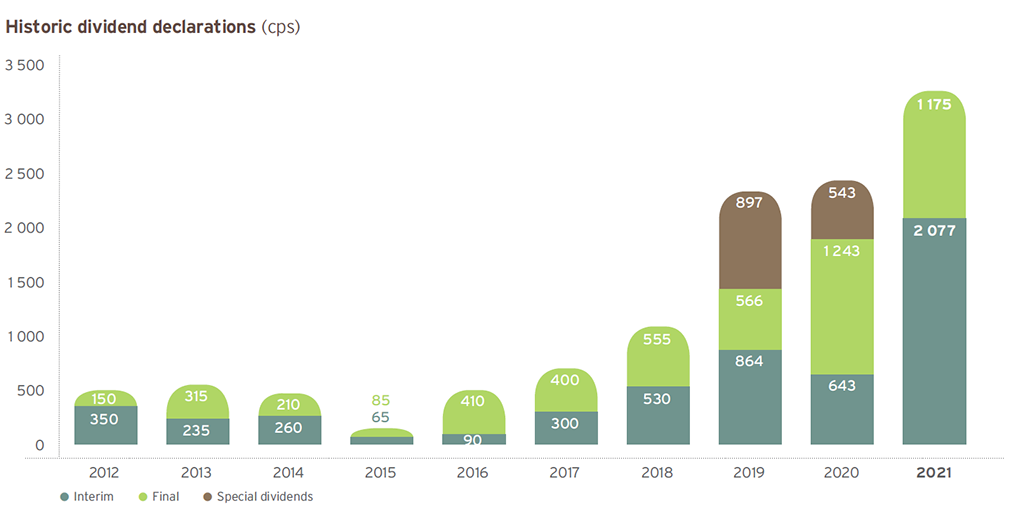Currently viewing: The year in brief | Next: 2.1 Responsibility statement on internal financial controls
 R32.8 billion
R32.8 billion R10.6 billion
R10.6 billion R10.7 billion
R10.7 billion R46.83 per share
R46.83 per shareGroup revenue increased by 13% to R32 771 million (2020: R28 924 million), mainly due to the increase in coal revenue and the inclusion of renewable energy revenue from Cennergi for the full 12 months compared to nine months in 2020.
Earnings increased 74% (or R5 384 million) to R12 667 million (2020: R7 283 million) or 5 128 cps (2020: 2 902 cps). The increase in earnings was mainly due to better profitability from controlled operations and higher equity-accounted income from SIOC, driven by high iron ore export prices and price premia.
Headline earnings increased to R11 568 million (2020: R7 417 million) or 4 683 cps (2020: 2 955 cps). There was a slight decrease in the WANOS to 247 million (2020: 251 million) as a result of shares repurchased and cancelled in terms of the R1.5 billion share repurchase programme. The total number of shares repurchased was 9 401 662 shares, representing 2.62% of Exxaro's issued share capital before the buy-back.
Refer note 5.3 for the detailed headline earnings reconciliation.
Cash flow generated by operations was up 36% to R10 552 million (2020: R7 770 million) and, together with the dividends received from our equityaccounted investments of R9 991 million (2020: R3 263 million), were sufficient to fund capital expenditure and ordinary dividends paid.
Following the disposal of Exxaro's remaining shareholding in Tronox Holdings plc for R5 763 million, a special dividend of R1 363 million was paid to external shareholders, and a share repurchase programme of R1.5 billion was implemented with the last trade executed on 2 November 2021.
Total capital expenditure decreased to R2 471 million (2020: R3 175 million), comprising R1 635 million sustaining capex and R836 million expansion capex.
Our positive operational results and monetisation of our investment in Tronox Holdings plc strengthened our statement of financial position, resulting in a net cash position of R764 million (excluding Cennergi's net debt of R4 482 million) at 31 December 2021 compared to net debt of R6 335 million (excluding Cennergi's net debt of R4 632 million) at 31 December 2020.
In April 2021, Exxaro also successfully refinanced its R8 billion loan facility with various financial institutions.
As a result, the group has sufficient liquidity to navigate through the current uncertain operating environment.

Chinese and Indian governments continue to wield significant influence over thermal coal seaborne markets by deploying domestic protectionist policies such as price controls, tariffs, and quotas. China's ban on Australian coal imports is also shifting more Australian coal to India, and imports from further afield into China.
After reaching record highs in mid-October 2021, thermal coal prices have started to ease as China's restrictions on power demand and supply intervention drove down domestic prices. However, current price levels are still well above marginal costs, owing to strong winter demand, a tight gas balance in Europe and the La Nina weather pattern bringing heavy rainfall and flooding to key exporters in the Pacific market. The lack of coal in the spot market in Australia, Russia and South Africa also provided support to high ash coal prices, whilst the Indonesian low-ranking coal has been more exposed to China's domestic coal price correction.
The domestic low CV market experienced subdued demand due to weak demand from Eskom. Most of the exporters prioritised railing high CV products to maximise returns on limited export rail availability, with the lower quality unsized export coal sold domestically to reduce high stockpiles.
Exxaro, along with other South African coal exporters, were severely constrained by a lack of sufficient logistical rail capacity. Locomotive unavailability remains a huge challenge, combined with cable theft, vandalism, and sabotage of rail infrastructure. This resulted in the industry only railing 58.1Mt to RBCT in 2021 (2020: 70.1Mt). Exxaro export volumes decreased by 37% from 12.2Mt in 2020 to 7.6Mt in 2021.
The average benchmark API4 RBCT export price of US$124 per tonne was 90% higher (2020: US$65 per tonne), resulting in a 100% increase in the average realised export price for Exxaro of US$96 per tonne (2020: US$48 per tonne).
The coal business's capital expenditure decreased 22% in 2021. Sustaining capital decreased 26% driven mainly by lower spend at Grootegeluk, Leeuwpan, Belfast and the disposal of ECC in September 2021. Expansion capital decreased 12% as we completed the construction on the GG6 project and the Belfast mine.
| Coal capex | 2021 Rm |
2020 Rm |
Change % |
|
| Sustaining | 1 564 | 2 110 | (26) | |
|---|---|---|---|---|
| Commercial – Waterberg | 1 285 | 1 683 | (24) | |
| Commercial – Mpumalanga | 261 | 411 | (37) | |
| Other | 18 | 16 | 13 | |
| Expansion | 836 | 950 | (12) | |
| Commercial – Waterberg | 705 | 643 | 10 | |
| Commercial – Mpumalanga | 131 | 307 | (57) | |
| Total coal capex | 2 400 | 3 060 | (22) |
Mafube, our 50% joint venture with Thungela, recorded equity-accounted income of R375 million (2020: R67 million). This increase is mainly due to higher export prices realised, partially offset by lower sales volumes and a stronger exchange rate.
The two Cennergi windfarms were operating at slightly lower than planned capacity due to lower than expected windspeeds, increased maintenance in low wind periods as well as the production time lost during the end of 5-year warranty inspections impacting energy generation negatively. Combined electricity generation was 724GWh (2020: 727GWh based on 12-month period).
Normalised Cennergi EBITDA margin exceeds 80%, which shows the consistency of earnings and margins underpinned by long-term offtake agreements.
The Cennergi project financing of R4 700 million (2020: R4 810 million) will mature over time and be fully settled in 2031. It has no recourse to the Exxaro balance sheet and is hedged through interest rate swaps at an effective rate of 11.9%.
The 48% increase in equity-accounted income from SIOC to R9 037 million (2020: R6 125 million), was primarily driven by the higher iron-ore prices and price premia.
An interim dividend of R6 329 million was received from our investment in SIOC in August 2021 (2H20: R1 706 million). SIOC declared a final dividend to its shareholders in February 2022. Exxaro's 20.62% share of the dividend amounts to R2 655 million, which is 58% lower than the interim dividend received. The dividend will be accounted for in the first half of 2022.
Exxaro concluded its strategy to monetise its investment in Tronox Holdings plc when Tronox Holdings plc exercised the "flip-in" call option for the Tronox SA shares. This became effective on 24 February 2021 and resulted in the deemed disposal of the Tronox SA shares in exchange for Tronox Holdings plc Ordinary Shares. On 1 March 2021, all the Tronox Holdings plc Ordinary Shares were sold.
On 8 April 2021, Exxaro signed an SPA to dispose of our ECC operation to Overlooked Colliery. All conditions precedent to the SPA were fulfilled and the transaction became effective on 3 September 2021.
The disposal process for Leeuwpan continues with definitive legal agreements envisaged to be signed in the first half of 2022, and regulatory approvals obtained thereafter.
Exxaro continues to evaluate its options to dispose of its 26% shareholding in Black Mountain.
The decarbonisation project management office (DPMO) was established in June 2021 to coordinate the decarbonisation activities across the group and compile a detailed baseline of our emissions. A multi-functional project team, comprising 10 functional and four cross-functional streams, has been established to develop a group-wide decarbonisation system and 2050 carbon neutrality pathway streams.
The team has compiled a detailed emissions baseline for the organisation and identified potential emission reduction opportunities from the planned projects. In the 2020 audited GHG emission data, Exxaro's total emissions were 66 000 ktCO2eq, with Scope 1 accounting for 0.49%, Scope 2 for 0.76% and Scope 3 for 98.75%. A detailed breakdown of our emissions sources reveals that:
The organisation has opportunities to reduce current Scope 1 and Scope 2 emissions by 40% by 2025 with the implementation of the following initiatives:
The implementation of the Grootegeluk renewable energy project will significantly reduce Exxaro's Scope 2 emissions, given the materiality of Grootegeluk's contribution. Additional GHG mitigation activities have been identified through the decarbonisation projects, and the team is refining the business case to ensure maximum value can be obtained for the organisation.
Our social investment and engagement activities continued from 2020 within the COVID-19 environment, taking the necessary precautions. Our primary focus was to execute our ESD programme and implementation of community infrastructure projects, especially those related to water supply.
We achieved a local procurement spend of 11.3%, equal to R1.05 billion compared to our target of 10% and a prior year achievement of 4.5%, doubling our local procurement spend to empower over 241 local black owned SMMEs.
During the year under review, we approved total ESD funding of R127.7 million to 15 SMMEs employing 243 people. We onboarded and provided support to 97 beneficiaries on the contractor development programmes, in partnership with the Gordon Institute of Business Science and 29 enterprise owners on a financial excellence programme with the SAICA enterprise development programme.
A total of R64 million was spent on the completion of schools, an ESD hub, water, and sanitation infrastructure projects through our Social and Labour Plans, in both Mpumalanga and Waterberg. A total of 205 jobs were created during the construction periods, with 53 484 community members being positively impacted, including 272 households, school children, women and youth entrepreneurs.
Changes in municipal leadership, post the local government elections, brought some stability which bodes well for current and future engagements and collaboration for local investment and community development.
We will remain prudent in returning cash to shareholders, managing debt, and selectively reinvesting for the growth of our business.
Our strategic approach to build our renewable energy business necessitated a review of our dividend policy, which was approved by the board of directors in March 2021.
The revised dividend policy is based on the following two components:
Exxaro will continue to target a gearing ratio of below 1.5 times net debt (excluding ring-fenced project financing) to EBITDA.
The board of directors has declared a cash dividend, comprising:
The gross final cash dividend of 1 175 cps, for the year ended 31 December 2021 was declared on 3 March 2022, and is payable to shareholders of ordinary shares on 9 May 2022.

 Report Index
Report Index Integrated Report 2021
Integrated Report 2021
